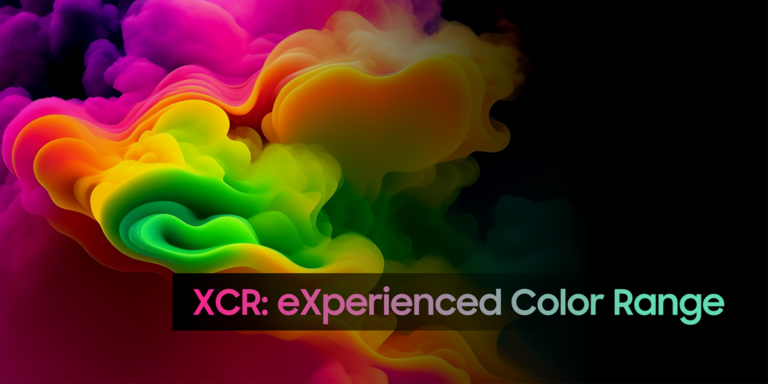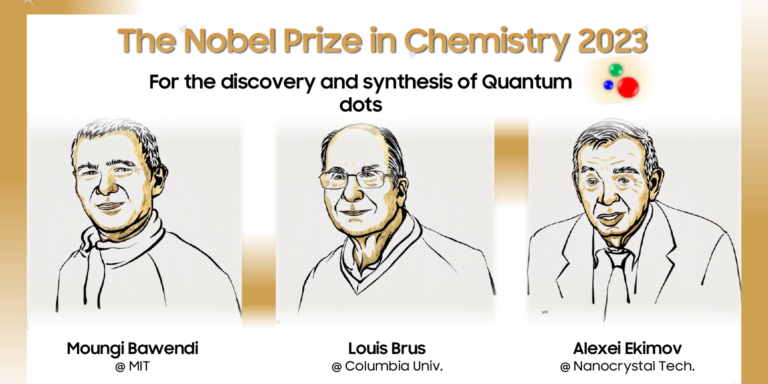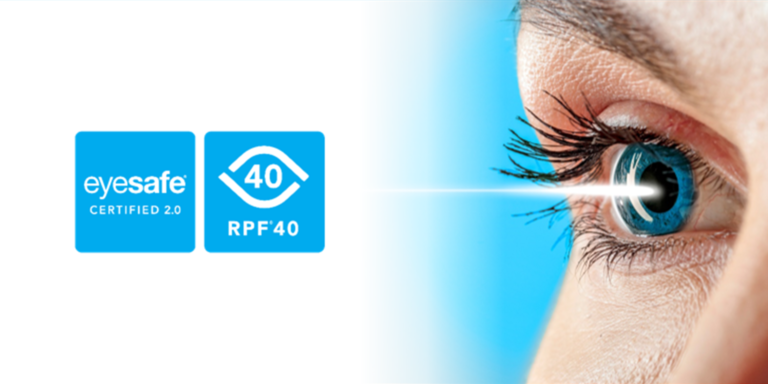

Introducing QD-OLED
This whitepaper will give you a firm understanding of what makes QD-OLED special and the many benefits of adopting the new QD-OLED platform.
Take the Quantum Leap with QD-OLED
QD-OLED combines the best in material engineering, quantum physics and vision science to create Stunning color — Dazzling details — Thrilling Experience. This is the world’s first display to integrate printed Quantum Dots with self-emitting layers producing blue light. The result is a viewing experience like no other!

Samsung Display is introducing QD-OLED for the home entertainment market in two TV sizes, 55” and 65”, along with a 34” curved gaming monitor.
QD-OLED

Nano-sized technology. Mind-blowing applications.
QD-OLED is composed of many ground-breaking innovations from Quantum Dots to self-emitting layers producing blue light and an Oxide TFT backplane. They’re packaged in an elegant 3-layer structure, which ensures that high-performance is achieved with slim design aesthetics. Unlike previous displays that were designed with Quantum Dot sheets, QD-OLED has red and green quantum dot material printed on each pixel. And unlike WOLED (white OLED) or LCD displays that rely on color filters to tune the image, QD-OLED’s color conversion, allows for a far superior color performance.
QD-OLED brings the best in material engineering, quantum physics and vision science to create unbeatable value for even the most discerning users.
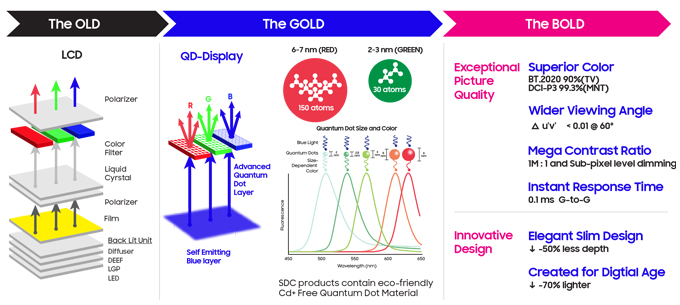
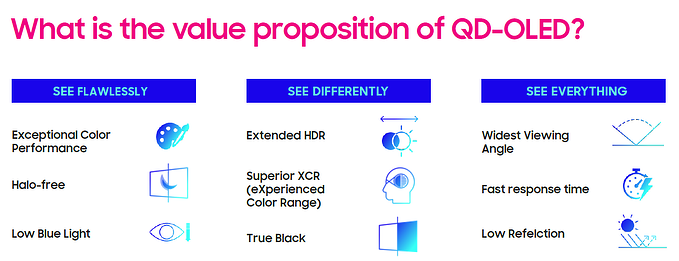
Color performance like you’ve never seen
Gamut, volume and uniformity
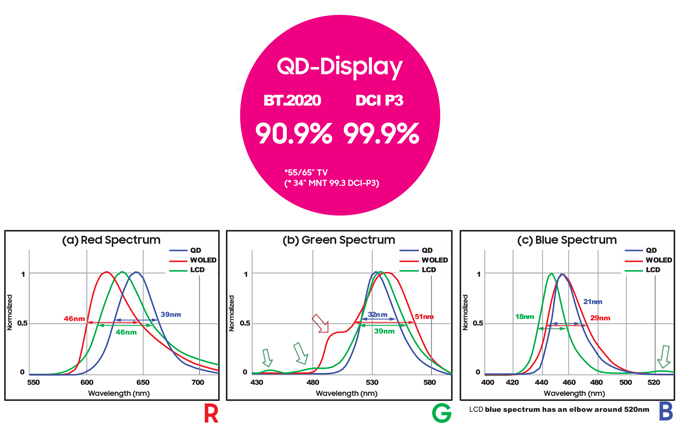
The QD-OLED’s narrow band, primary color emission provides the ideal tri-luminous source which has the power to create more than 90 percent coverage of BT.2020 and 99 percent coverage of the Digital Cinema Initiatives’ DCI-P3 color space. This unparalleled color representation can reproduce almost all of the colors visible in nature.
How does this compared to WOLED? WOLED’s light source of blue and yellow OLED stacks have a broad spectrum, with each pixel consisting of four RGB+W sub-pixel structures. Color is created by light passing through a color filter (CF), which reduces overall light efficiency and requires ongoing luminance adjustment. Because of WOLED’s RGB+W pixel structure and a broader bandwidth color filters, the result is often unsaturated colors. On the other hand, the QD-OLED’s full width at half maximum (FWHM) is
20 to 40 nanometers (nm) wide, which are 10 to 20nm narrower than that of WOLED displays. Thus, each primary will render its own color with remarkable clarity and allow more accurate combinations to create more than one billion distinct colors. In other words, the QD-OLED’s slim spectral cones results in high color purity!
The brightest brights and darkest darks
Brighter luminance and inkier blacks
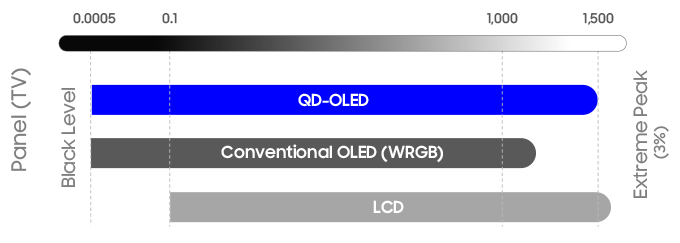
When it comes to illumination, it’s not about brightness, peak or typical, but about highlights in that matter. The level of detail increases dramatically when only specific areas are highlighted, and QD-OLED provides the lowest measurable black level of 0.0005 nits, achieving a true black unlike any other. QD-OLED also uses true RGB additive light create perfect whites and high luminosity, providing the perfect complement to your HDR experience with an infinite contrast ratio.
Compare that to transmissive screens, which are equipped with a separate backlight. To create blacks, these “always-on” backlights are blocked by the liquid crystals. Even with advanced designs like dimming zones some light escapes resulting in blacks that often look gray! With QD-OLED you can see ‘shadow details’ rendered with exceptional clarity and integrity; in fact, you may uncover previously unseen details in your favorite films, unlocking a totally new experience.
XCR Experienced Color Range
QD-OLED provides exceptional XCR range, almost 1.6x wider than contemporary LCDs that publicize their higher peak luminance. The relatively new concept of XCR is being refined and we recommend you follow industry updates as color and vision experts further define this metric. Learn more.
Experience details in the dark
Let’s take a moment to better understand the ‘color’ of true black through the concept of contrast. A contrast ratio is the ratio between the maximum and minimum brightness, or in other words, the ratio between the brightest white and the darkest black. In general, a display has a limit in brightness, due to ancillary problems such as light source constraints and power consumption. But there is no limit in depicting darkness because you can simply turn off the light and make any given area black. Yet, this is NOT possible with many displays, which control their light source via dimming zones encompassing many, many pixels.
The QD-OLED, on the other hand, has a perfect black level because it can individually turn off each pixel. But control local dimming at a sub-pixel level! QD-OLED can produce Deepest blacks!
None of the halo. All of the sharpness.
QD-OLED’s have millions of self-emitting pixels that can adjust overall luminance with pinpoint accura- cy. A brightly lit pixel can be next to a black pixel, thereby producing sharp character edges for images as well as subtitles. With QD-Display, viewers can focus on the movie without any annoying distractions.
IPS LCD displays cannot match this performance.
To compensate for inferior black delivery and lower contrast ratio, some displays have looked to improve by increasing brightness. Though some LCD devices implement local dimming to improve contrast and image quality, the process is not perfect. Often, as LCD devices try to boost brightness, this creates a halo effect around a bright object on a dark background that can cause artifacts such as subtitle blooming.
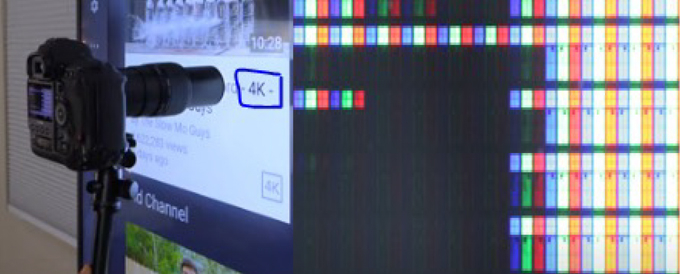
Source
All of the action. None of the strain.
The QD-OLED has one of the lowest levels of potentially harmful blue light among comparative displays, typically 40 to 50% less than an LCD display, partly because the combined FWHM bandwidth is only 20nm and the blue spectral peak has a wavelength slightly longer than that of a typical LCD backlight. Generally speaking, the blue light of the QD-OLED’s self-emitted light layer is fine-tuned to minimize the wavelengths in the harmful blue-light zone.
Blue light is the portion of the visible light spectrum with the shortest wavelenghts and the highest energy.
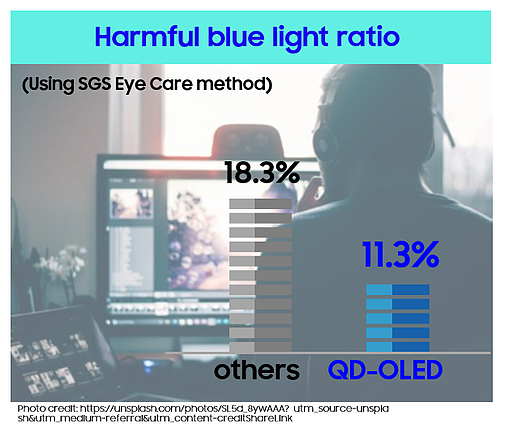
Every seat is the best seat in the house
The QD-OLED enables a wider viewing angle than WOLEDs or IPS LCDs. This is enabled due to [1] dome-shaped flux structure and [2] the fact that is a top-layer emission display. More than 80 percent of the luminance in QD-OLED is maintained at 60 degrees off-axis, and color shift remains well below 0.01 of Δu’v’.
Superior side-viewing performance makes the QD-OLED the perfect family entertainment platform and ensures every seat in the house provides an uncompromising experience. Skin tones look more natural and realistic, enhancing the feeling of immersion. This feature brings a great deal of value to the monitor user, especially if you work in a collaborative office or have standing desks that require you to have differing vertical viewing angles. With QD-OLED, you will always have a clear view of the contents on-screen!

The motion clarity authority
QD-OLED provides an almost instantaneous native (G to G) response time of 0.1Ms. Modern displays are sample-and-hold devices (e.g., an image is rendered and held for the frame time of 16.7ms for a 60Hz refresh). All is well if the image is still, but once the image moves, the eye wants to pursue the motion smoothly. For LCD displays, the response slope is very slow. Because of its faster response time, QD-OLED’s transition edge is closest to the ideal scenario. With this steeper transition edge, the QD-OLED is able to re-create motion with significantly less blur.
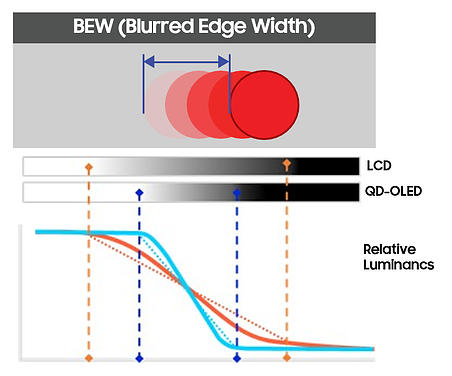
Minimum reflection. Maximum detail.
Lastly, let’s take a look at screen reflection, which is an undesirable characteristic of glass displays.
Display engineers employ a number of innovative techniques to minimize this unwanted light, and based on individual viewing conditions, the amount of reflective light can be a very important performance metric.
QD-OLED provides an industry-leading SCI reflection of only 1.1%.
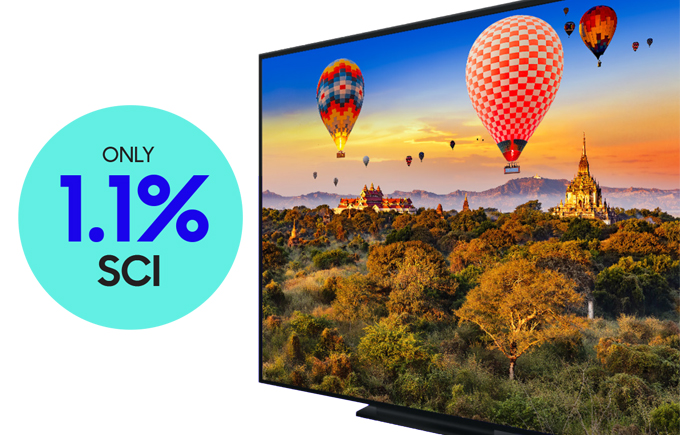
That leads to an important question: Among self-emitting displays, why does the QD-Display have a distinctly lower SCI measurement?
WOLED is a bottom-emitting display (light is emitted through a transparent bottom) and has a metallic backplane near the top surface. While this usually is a very thin metal layer of aluminum or silver, its position at the surface near the top increases light reflection regardless of the thickness of the layer. On the other hand, QD-Display is a top-emitting display, sending light that is essentially non-reflective away from the sub- strate and the backplane circuit, both of which are located at the bottom of the panel.
It’s important to note that a lower reflection level increases the “perceived” contrast ratio of a TV.
